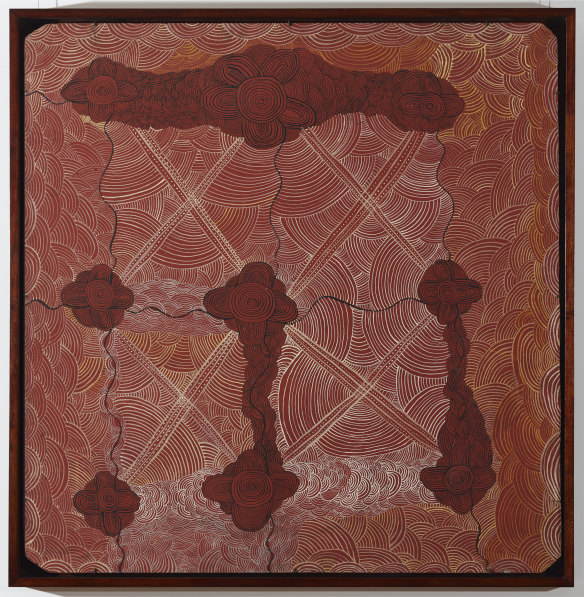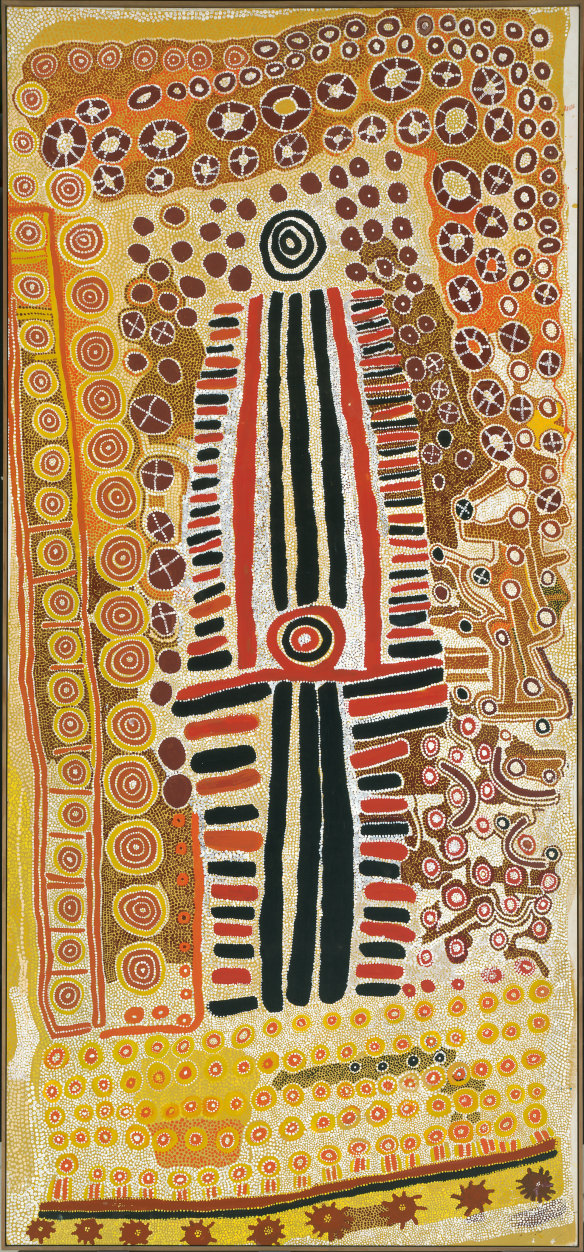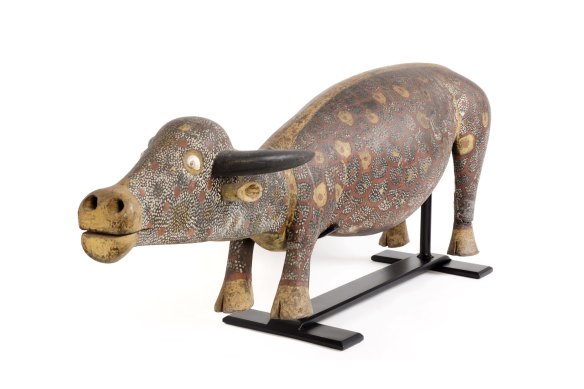
Not so long ago, Aboriginal art was fighting for a place in the mainstream, trying to shake off the anthropological baggage that allowed sceptics to dismiss its claims to contemporary relevance. White fellas made “art”, black fellas made artefacts. It wasn’t all that different to a once-popular distinction between men who made art, and women who had a hobby.
That white, male orthodoxy has been slowly deteriorating for decades, but the last few years have witnessed an almost total collapse. The Indigenisation of Australian art is now rocket-fuelled. No exhibition is complete without First Nations content, no wall label does without an Aboriginal place name, and no event without an acknowledgement of elders. It’s not simply a matter of getting the balance right, it’s a concerted attempt to grab back everything taken away by colonisation. Should we be concerned? Only if this so-called decolonisation of the museum ushers in another, equally narrow orthodoxy that restricts rather than broadens our appreciation of art.
Emily Kame Kngwarrey’s Yam Wwely (1995).
I was left pondering these issues after finally getting to see Ever Present: First Peoples Art of Australia, at the National Gallery Singapore. Featuring more than 170 works by 150 artists this is reputedly the largest display of Aboriginal art ever seen at a museum in Asia. Another historic first is that the show is a public-private collaboration between the National Gallery of Australia and the Wesfarmers collection. Museums have avoided such arrangements in the past, but as they are forced to turn increasingly to the private sector for support, Ever Present offers a glimpse of the future.
As with all large surveys, the NGS show sacrifices depth to breadth, including only one work apiece by many important artists. The biggest names, such as Emily Kame Kngwarreye and Rover Thomas, do a little better. One of the key public-private pairings sees Kngwarreye’s Yam awely, from the NGA collection, hung alongside her Anaty Inger (Bush Potato Dreaming) from the Wesfarmers Collection. Both works date from 1995 but are painted in different styles. The former features long, flowing brushstrokes, resembling tangled root systems, the latter is a mass of small dots and daubs laid down in dense clusters.
Another eye-opening juxtaposition brings together two Wandjina paintings by Alec Mingelmanganu, showing subtly varied approaches to the way this legendary artist painted those famous spirit figures.
The lesson is that the best artists never stand still, being constantly drawn in new directions as instinct and intuition demand. This can only be assessed when an artist is represented by two or more works.
Untitled (Kalipinya) (1972), by Long Jack Phillipus Tjakamarra.
In defence of the more-is-more strategy, there are pieces with such iconic power we need no further convincing about an artist’s abilities. Here I’m thinking of a surprisingly large early Papunya painting, Untitled (Kalipinya) (1972), by Long Jack Phillipus Tjakamarra. This is one hell of a picture to be hanging in Wesfarmers’ corporate offices. From the NGA, there’s Albert Croker’s irresistible sculpture, The Buffalo (c. 1959); or Yanjilypiri Jukurrpa (Star Dreaming) (1985), a joint effort from three notable Warlpiri artists, Paddy Jupurrurla Nelson, Paddy Japaljarri Sims, and Kwentwentjay Jungarrayi Spencer.
There are two areas in the exhibition that tease out connections with South-East Asia. The first is the trepang (sea cucumber) trade that existed between the people of Arnhem Land and the Maccassans that ended in the early years of the 20th century but left a residual cultural legacy. A small bark painting of c.1974 by Nandabitta Maminyamandja that shows the Macassans catching and preparing trepang, reveals how strongly the old trade links remained etched in the memories of the local people.
The second is the batik work made by women at Ernabella and Utopia, beginning in the 1970s, which led to a new range of expression in a medium thought of as typically Indonesian. Batiks, by Emily Kngwarreye and others, must be truly surprising to anyone accustomed to the traditional forms and motifs of Indonesian work. The artists drew on their own stories to provide an entirely unique iconography, reminding us that batik, after all, is a technique, not a rigid school of thought.
Yanjilypiri Jukurrpa (Star Dreaming) (1985), a joint effort from three notable Warlpiri artists, Paddy Jupurrurla Nelson, Paddy Japaljarri Sims, and Kwentwentjay Jungarrayi Spencer.
When I asked how Singaporean audiences had responded to the exhibition, I was told there was a general sense of surprise at the highly contemporary nature of much of the work. It was made clear this was a pleasant surprise, not a negative one.
In this respect, the Singaporeans were rather more tolerant than me because I felt the major drawback with the selection was that it was too laden with photography, video and activist art, at the expense of pieces with more aesthetic and spiritual power. For instance, it was surprising to see no fewer than three works by Vernon Ah Kee, but not a single piece by an artist such as Gunybi Ganambarr. The inevitable Richard Bell was represented by a massive painting from the Wesfarmers’ collection and the globe-trotting Embassy installation (officially owned by Sydney’s Museum of Contemporary Art), but there was nothing by artists as significant as David Malangi, Mick Kubarkku, Jarinyanu David Downs, Eubena Nampitjin, Ginger Riley, and so on. One of those blue barks by Dhambit Munungurr would have been a sensation.
Albert Croker’s The Buffalo (circa 1959).
I know it’s a good policy to review the works in the show rather than those one might have preferred to see, but the main point is that the selection felt skewed by political considerations. This extends to NGA curator, Tina Baum, writing her catalogue entries and wall labels in the first person plural as if she were speaking for all Aboriginal people. Some will welcome this as a gesture of solidarity, but Aboriginal art and society are so heterogeneous it seems like an extraordinary overreach to cram everybody under one ideological umbrella. Perfect objectivity may be a fiction, but for public institutions, it’s a useful and dignified fiction.
While I’m assured Ever Present was well-received in Singapore, many viewers must have been surprised by some of the work and the rhetoric, which reflect the increasing obsession with identity politics in Australian museums. Naturally, the same ideas exist in Singapore too, even allowing for the notorious parentalism of the government, but it’s a strange show that gives the impression Aboriginal people are in perpetual conflict with an oppressive, white state. There’s so much we can learn from Indigenous society in terms of tolerance, sharing, and caring for the land, that it would have been desirable to emphasise those aspects more fully. If we’re ever going to get along with each other, black and white, museums and corporates, Australia and Asia, we need to stop thinking in terms of victims or adversaries and cultivate simple goodwill.
Ever Present: First Peoples Art of Australia is at the National Gallery Singapore until September 25.
John McDonald flew to Singapore as a guest of Wesfarmers.
To read more from Spectrum, visit our page here.
Most Viewed in Culture
From our partners
Source: Read Full Article



